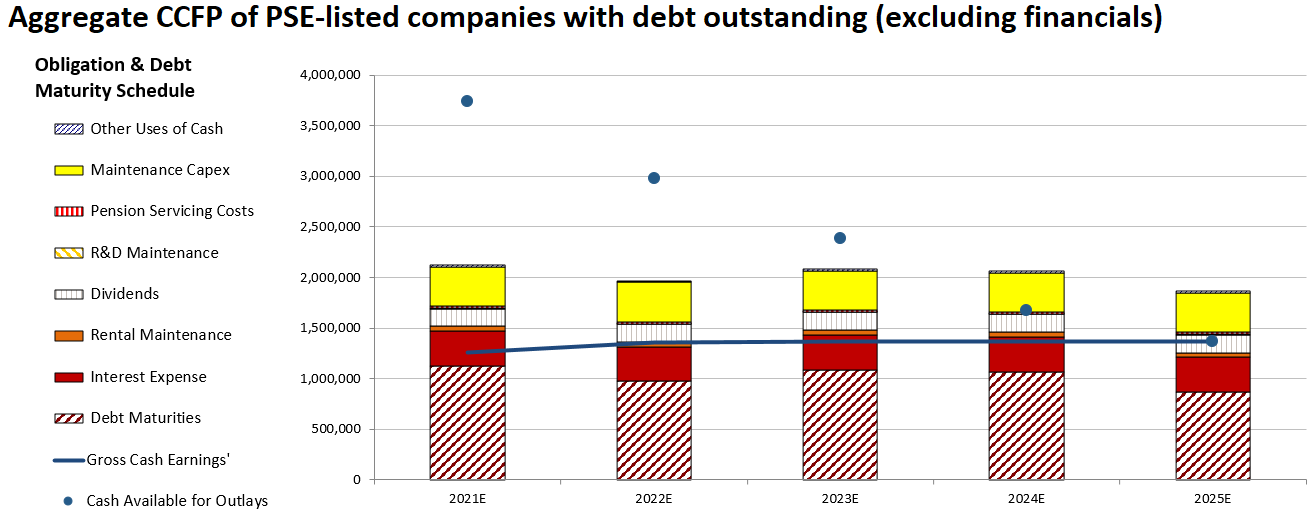MONDAY MACRO: 2020 Uniform data shows that Philippine corporations are still at little risk of default

As the quarantine in the Philippines continues to prolong, some may be worried about the heightened credit risk it puts on Philippine corporations. In the extreme scenario, the inability of companies to generate enough cash could force them to default on debt obligations.
However, as we’ve indicated in the past, companies listed on the Philippine Stock Exchange (PSE) continue to be at little risk of bankruptcy. Even by removing those that do not hold debt, PSE-listed companies remain safe in the near-term.
Philippine Markets Daily:
The Monday Macro Report
Powered by Valens Research
COVID-19 has broken a lot of business trends in 2020, including corporate ROAs. This is expected as the pandemic has disrupted people’s way of living around the world.
One trend it hasn’t broken though is the growth of corporate debt. In 2020, the total debt of non-financial Philippine corporations continued to rise to new highs at PHP 8 trillion.

With Uniform ROAs dropping during the year, many have been worried that the Philippine business sector is headed towards a mass default scenario. In fact, a third stimulus package, termed as Bayanihan 3, is currently being discussed in Congress.
In June last year, we discussed how major Philippine corporations were actually at little risk of a credit default amidst the recession. Even the companies that have been struggling the most in this pandemic were able to significantly improve their credit profile, specifically the airline stocks.
Thanks to the Bangko Sentral ng Pilipinas (BSP) and the past Bayanihan Acts, interest rates have been at its historical low near 2% and due dates of loans have been allowed to extend. With such low borrowing costs, it has been very easy for companies to refinance near-term debt maturities.
As a result, if we look at the recently filed 2020 annual reports, the aggregate credit profile of Philippine corporations continues to be safe. Even when excluding the companies that are not holding debt, the point remains for the near term.
The chart below shows the Credit Cash Flow Prime of every non-financial company in the Philippine Stock Exchange that is not holding debt. The bars in the chart represent each obligation companies need to fulfill, which are mainly composed of debt, interest costs, and maintenance capex.

The bars at the top are the most flexible and can be delayed if necessary. Pushing these back could stifle potential growth, but it will keep the affected companies afloat.
Meanwhile, the bars at the bottom are the most important and must be addressed. If companies fail to meet these, then bankruptcy will likely be imminent.
The CCFP chart shows that the cash flows (blue line) of the group are estimated to be insufficient at satisfying all obligations each year through 2025. This is expected as the pandemic has substantially impacted the ability of almost every company to generate earnings.
For cash flows alone to meet obligations, companies would need to halt dividends, severely reduce capex, and continue refinancing debt. These actions would be difficult to execute altogether.
However, when including each company’s cash on hand (blue dots), annual obligations would be easily met until 2023. By then, the group would really be forced to improve liquidity to prevent a mass default scenario.
Companies have enough cushion to improve their financial standing before 2024. As long as interest rates remain low, there is still plenty of time to refinance existing debt.
More importantly, the development of COVID-19 vaccines has ensured the impending end of the pandemic and the accompanying recession. Cash flow estimates will likely face upward revisions as soon as the economy shows signs of recovery.
The CCFP chart will likely have a different trend by then.
About the Philippine Market Daily
“The Monday Macro Report”
When just about anyone can post just about anything online, it gets increasingly difficult for an individual investor to sift through the plethora of information available.
Investors need a tool that will help them cut through any biased or misleading information and dive straight into reliable and useful data.
Every Monday, we publish an interesting chart on the Philippine economy and stock market. We highlight data that investors would normally look at, but through the lens of Uniform Accounting, a powerful tool that gets investors closer to understanding the economic reality of firms.
Understanding what kind of market we are in, what leading indicators we should be looking at, and what market expectations are, will make investing a less monumental task than finding a needle in a haystack.
Hope you’ve found this week’s macro chart interesting and insightful.
Stay tuned for next week’s Monday Macro report!
Regards,
Angelica Lim
Research Director
Philippine Markets Daily
Powered by Valens Research
www.valens-research.com




